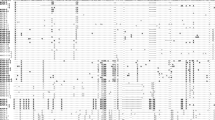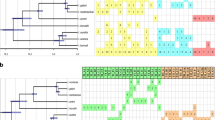Abstract
Satellite DNA is highly abundant in Alphitobius diaperinus (Tenebrionidae, Coleoptera), comprising 25% of the total genomic DNA. Sequence analysis reveals an average GC content of 50.8% and the presence of three different groups of satellite monomer variants, tH1, tH2 and tH3 with corresponding lengths of 123, 128 and 126 bp. Their mutual homologies range between 65 and 81 %. Sequence comparison shows that the monomer variant tH2 has been formed by a recombination process between tH1 and tH3, which have a low average homology of only 65.15%. The longest stretch of 100% homology between the recombining units is 17 bp and is located 3′ to the predicted recombination site. There is also an indication from sequence analysis that replication slippage and gene conversion play a part in the formation of satellite units and contribute to their divergence. The tH1, tH2 and tH3 monomer variants are organized in higher order repeating structures: a dimer, composed of tH1, and tH3, and a trimer containing tH1, tH2 and tH3 in series. The dimeric and trimeric repeat units furthermore create three higher order satellite subfamilies. Two of them contain either tandemly arranged dimers or trimers, while the third one is composed of both types of repeats, mutually interspersed.
Similar content being viewed by others
References
Davis CA, Wyatt GR (1989) Distribution and sequence homogeneity of an abundant satellite DNA in the beetle Tenebrio molitor. Nucleic Acids Res 17:5579–5586
Dover GA (1982) Molecular drive: a cohesive model of species evolution. Nature 299:111–117
Dover GA (1986) Molecular drive in multigene families: how biological novelties arise, spread and are assimilated. Trends Genet 168:159–165
Drouin G, Dover GA (1990) Independent gene evolution in the potato actin gene family demonstrated by phylogenetic procedures for resolving gene conversion and the phylogeny of angiosperm genes. J Mol Evol 31:132–150
Hancock JM (1993) Evolution of sequence repetition and gene duplications in the TATA-binding protein TBP (TFIID). Nucleic Acids Res 21:2823–2830
Horz W, Zachau HG (1977) Characterization of distinct segments in mouse satellite DNA by restriction nucleases. Eur J Biochem 73:383–392
Jeffreys AJ, Wilson V, Thein SL (1985) Hypervariable “minisatellite” regions in human DNA. Nature 313:67–73
Jones CW, Kafatos FC (1982) Accepted mutations in a gene family: evolutionary diversification of duplicated DNA. J Mol Evol 19:87–103
Juan C, Gosalves J, Mezzanotte R, Petitpierre E (1991) Cytological and biochemical characterization of the in situ endonuclease digestion of fixed Tenebrio molitor chromosomes. Chromosoma 100:432–438
Juan C, Vazquez P, Rubio JM, Petitpierre E, Hewitt GM (1993) Presence of highly repetitive sequences in Tribolium flour-beetles. Heredity 70:1–8
Kiyama R, Okumura K, Matsui H, Bruns GAP, Kanda N, Oishi M (1987) Nature of recombination involved in excision and rearrangement of human repetitive DNA. J Mol Biol 198:589–598
Petitpierre E, Gatewood JM, Schmid CW (1988) Satellite DNA from the beetle Tenebrio molitor. Experientia 44:498–499
Plohl M, Borštnik B, Lucijanić-Justić V, Ugarković Đ (1992) Evidence for random distribution of sequence variants in Tenebrio molitor satellite DNA. Genet Res 60:7–13
Plohl M, Lucijanić-Justić V, Ugarković Đ, Petitpierre E, Juan C (1993) Satellite DNA and heterochromatin of the flour beetle Tribolium confusum. Genome 36:467–475
Sambrook J, Fritsch EF, Maniatis T (1989) Molecular cloning: A laboratory manual. Cold Spring Harbor Laboratory Press, Cold Spring Harbor, New York
Sanger F, Nicklen S, Coulson AR (1977) DNA sequencing with chain-terminating inhibitors. Proc Natl Acad Sci USA 74:5463–5467
Smith GP (1976) Evolution of repeated DNA sequences by unequal crossover. Science 191:528–535
Stephan W (1989) Tandem-repetitive noncoding DNA: forms and forces. Mol Biol Evol 6:198–212
Strachan T, Webb D, Dover GA (1985) Transition stages of molecular drive in multiple-copy DNA families in Drosophila. EMBO J 4:1701–1708
Tautz D, Trick M, Dover GA (1986) Cryptic simplicity in DNA is a major source of genetic variation. Nature 322:652–656
Ugarković Đ, Plohl M, Gamulin V (1989) Sequence variability of satellite DNA from the mealworm Tenebrio molitor. Gene 83:181–183
Ugarković Đ, Plohl M, Lucijanić-Justić V, Borštnik B (1992) Detection of satellite DNA in Palorus ratzeburgii: analysis of curvature profiles and comparison with Tenebrio molitor satellite DNA. Biochimie 74:1075–1082
Walsh JE (1987) Persistence of tandem arrays: implication for satellite and simple-sequence DNAs. Genetics 115:553–567
Author information
Authors and Affiliations
Additional information
Communicated by D.J. Finnegan
Rights and permissions
About this article
Cite this article
Plohl, M., Ugarković, Đ. Analysis of divergence of Alphitobius diaperinus satellite DNA — roles of recombination, replication slippage and gene conversion. Molec. Gen. Genet. 242, 297–304 (1994). https://doi.org/10.1007/BF00280419
Received:
Accepted:
Issue Date:
DOI: https://doi.org/10.1007/BF00280419




